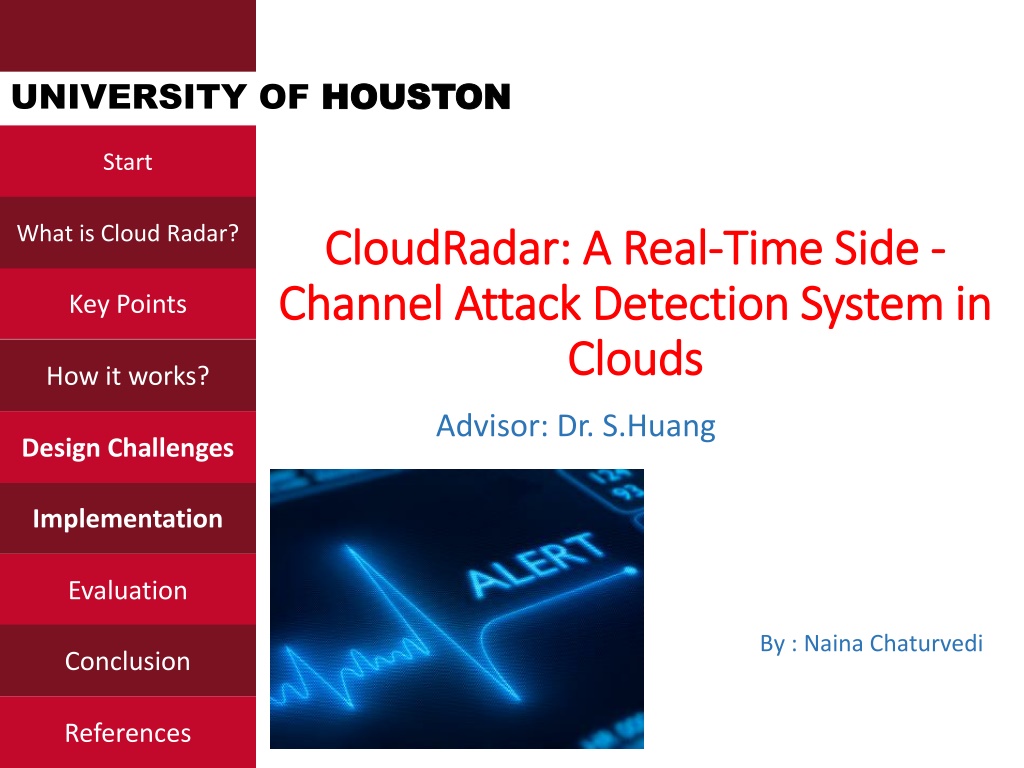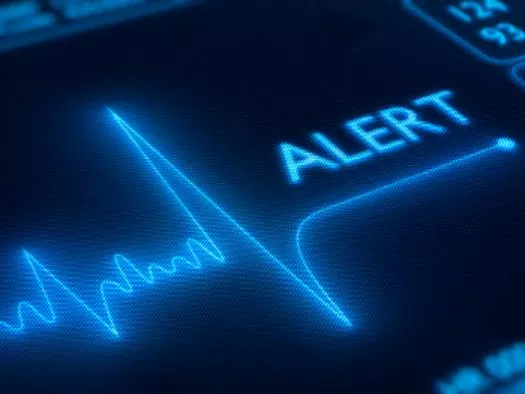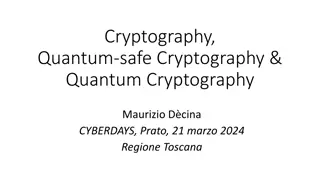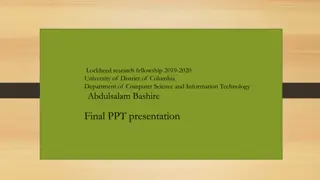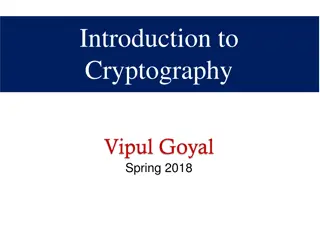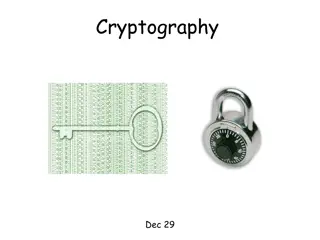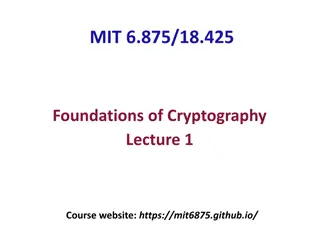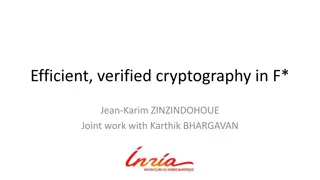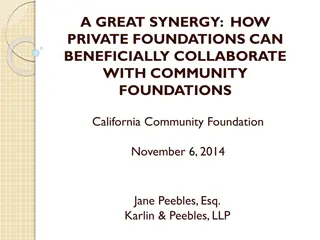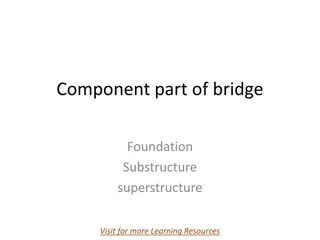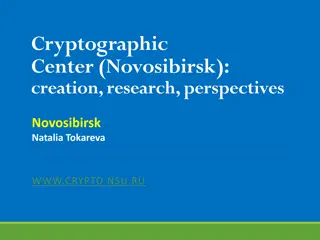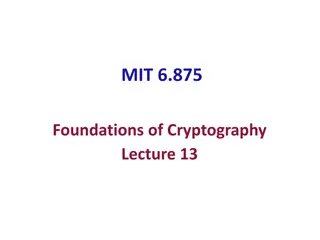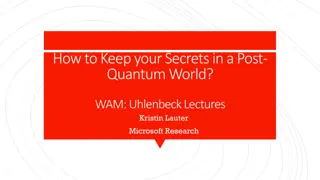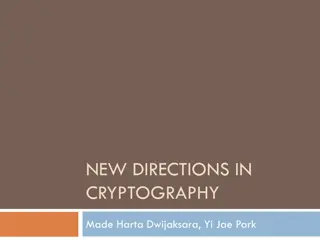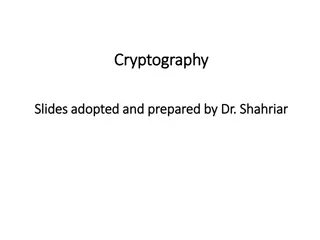Foundations of Cryptography: Digital Signatures
Learn about digital signatures, message authentication codes, and their applications in cryptography. Understand the difference between digital signatures and MACs, the concept of non-repudiation, and the security aspects of digital signature schemes.
Download Presentation

Please find below an Image/Link to download the presentation.
The content on the website is provided AS IS for your information and personal use only. It may not be sold, licensed, or shared on other websites without obtaining consent from the author.If you encounter any issues during the download, it is possible that the publisher has removed the file from their server.
You are allowed to download the files provided on this website for personal or commercial use, subject to the condition that they are used lawfully. All files are the property of their respective owners.
The content on the website is provided AS IS for your information and personal use only. It may not be sold, licensed, or shared on other websites without obtaining consent from the author.
E N D
Presentation Transcript
UNIVERSITY OF HOUSTON HOUSTON Start What is Cloud Radar? CloudRadar CloudRadar: A Real Channel Attack Detection System in Channel Attack Detection System in Clouds Clouds : A Real- -Time Side Time Side - - Key Points How it works? Advisor: Dr. S.Huang Design Challenges Implementation Evaluation By : Naina Chaturvedi Conclusion References
UNIVERSITY of HOUSTON HOUSTON | TECHNOLOGY What is Cloud Radar?? What is Cloud Radar? CloudRadar, a system to detect, and hence mitigate, cache-based side-channel attacks in multi-tenant cloud systems. It exploits signature-based detection to identify when the protected virtual machine (VM) executes a cryptographic application, at the same time, it uses anomaly-based detection techniques to monitor the co- located VMs to identify abnormal cache behaviors that are typical during cache- based side-channel attacks.
UNIVERSITY of HOUSTON HOUSTON Cache-based side-channel attacks and Multi-Tenant System A side-channel attack is any attack based on information gained from the physical implementation of a system, rather than exploting brute force or theoretical weaknesses in the algorithms. Cache-based side- channel attacks For example, timing information, power consumption, electromagnetic leaks or even sound can provide an extra source of information, which can be exploited to break the system. Multi-Tenant System Cache-based side-channel analysis is a new technique that uses the application-specific behavior of cache memory to leak secret information about a running algorithm to the attacker. the two events offer strong evidence of side-channel attacks. In this paper , the author show that correlation in the occurrence of Multi-tenant cloud systems : a software architecture in which a single instance of software runs on a server and serves multiple tenants. A tenant is a group of users who share a common access with specific privileges to the software instance. It s the feature to maximize resource utilization by consolidating virtual machines (VMs) leased by different tenants on the same physical machine.
UNIVERSITY of HOUSTON HOUSTON Signature-based detection and Anomaly-based detection Signature based detection : Operate in the same way as a virus scanner, by searching for a known identity or signature for each specific intrusion event. Signature-based detection Like anti-virus software, depend on receiving regular signature updates, to keep in touch with variations in hacker technique. Signature-based IDS is only as good as its database of stored signatures. Anomaly-based detection Anomaly-based detection : is an intrusion detection system for detecting both network and computer intrusions and misuse by monitoring system activity and classifying it as either normal or anomalous. The two phases of a majority of anomaly detection systems consist of the training phase (where a profile of normal behaviors is built) and testing phase (where current traffic is compared with the profile created in the training phase)
UNIVERSITY of HOUSTON HOUSTON Two Key Points 1.The victim has unique micro-architectural behaviors when executing cryptographic applications that need protection from side-channel attacks. So the cloud provider is able to identify the occurrence of such events using a signature-based detection method. Key Points 2. The attacker VM creates an anomalous cache behavior when it is stealing information from the victim.
UNIVERSITY of HOUSTON HOUSTON Two Key Points Positives and Negatives In this table, true positive , false negative , false positive and true negative are events The false positive rate is the proportion of all negatives that still yield positive test outcomes, i.e., the conditional probability of a positive test result given an event that was not present. Specificity (also called the true negative rate) measures the proportion of negatives that are correctly identified as such (e.g., the percentage of healthy people who are correctly identified as not having the condition).
UNIVERSITY of HOUSTON HOUSTON How it works ?? 1.Utilizes the existing host system facilities to collect micro-architectural features from hardware performance counters that are available in all modern commodity processors. How it works? 2.Non-intrusively interacts with the existing virtualization framework to monitor the VM s cache activities while inducing little performance penalty. Results : It effectively detects side-channel attacks with high true positives and low false positives. CloudRadar achieves : The first approach to detect cache side-channel attacks using techniques that combine both signature-based and anomaly-based detection techniques. A non-intrusive system design that requires no changes to the hardware, hypervisor and guest VM and applications, which shows potential of immediate adoption in modern clouds. Full prototype implementation and extensive evaluation of the proposed approach and detection techniques.
UNIVERSITY of HOUSTON HOUSTON Defenses Against Side-Channel Attacks Partitioning caches: Prevent the cache sharing by dividing the cache into different zones by users or ways for different VMs. Defenses Against Side-Channel Attacks Randomization: Add randomization to the attacker s measurements, making it hard for him to get accurate information based on his observations. Avoiding co-location: VM placement policies were designed to reduce the co-location probability between victim and attacker VMs. Performance counters were originally designed for software debugging and system performance tuning. Intrusion Detection Using Hardware Performance Counters But they can be used to detect security breaches and vulnerabilities. The performance counters can reveal programs execution characteristics, which can further reflect the programs security states.
UNIVERSITY of HOUSTON HOUSTON Design Challenges Main Focus : Focus on cross-VM side-channel threats in public IaaS clouds that are shared between processor cores. Design Challenges Signature based detection system : Signatures of side-channel attacks must be generated from all known side- channel attack techniques and used to compare with events collected from production systems. Cloud Radar Design Overview : Features used by CloudRadar are hardware event values read from the performance counters available in commercial processors. key insight for motivation : Is in cache side-channel attacks, to effectively exfiltrate secret information from the victim s sensitive execution, the attacker needs to repeatedly conduct side-channel activities and deduce his own cache uses based on the execution time of his own memory activities. Then makes inferences using Pattern !! if such distinction can be detected by the attacker using timing channels, it can be detected by the cloud provider using performance counters. Cloud Radar Design Overview
UNIVERSITY of HOUSTON HOUSTON Implementation Implementation Generating Cryptographic Signature : Indicate to the Cloud Controller what sensitive applications to be protected, by providing the signatures generated offline using performance counters. Cloud Controller will run these crypto programs on a dedicated server with the same configuration as the Cloud Server that hosts the protected VM, and use performance counters to generate the signatures for the customer. The signatures will be stored in the Signature Database for future reference. They will also be sent to the Cloud Server that hosts this VM.
UNIVERSITY of HOUSTON HOUSTON Implementation Implementation Detecting Cryptographic Applications : Victim Monitor monitors the protected VM using performance counters. It periodically (e.g., every 100 s) records the event counts as a time sequence. Signature Detector keeps comparing the most recent window of data points in the sequence with the signature. If a signature match is found, the Signature Detector can identify the protected VM is performing a cryptographic application, and signal this result to the Attacker Monitor.
UNIVERSITY of HOUSTON HOUSTON Implementation Implementation Monitoring Cache Activities :The Attacker Monitor exploits performance counters to monitor all untrusted VMs simultaneously. Attacker Monitor identifies active vCPUs . Attacker Monitor uses a kernel module to check the state and CPU affinity of each vCPU of each VM . The Attacker Monitor marks the vCPUs in the running state that are sharing the same LLC with the protected VM as monitored. Then it sets up performance counters to measure each monitored vCPU s cache misses and hits in turn. When the Attacker Monitor is notified that a cryptographic application is happening in the protected VM, it will compare each monitored vCPU s cache misses and hits.
UNIVERSITY of HOUSTON HOUSTON Implementation Implementation Eliminating Side Channels : Once the Attack Monitor notices that one co-tenant VM has abnormal cache behavior exactly when the protected VM executes cryptographic applications, it will raise alarm for side-channel attacks. The Cloud Controller will report this incident to the cloud provider for further processing such as shut down the malicious VM or eventually block the attacker s account. Attacker Monitor uses a kernel module to check the state and CPU affinity of each vCPU of each VM
UNIVERSITY of HOUSTON HOUSTON Accuracy of Cryptographic Operation Detection To detect a cryptographic operation, we used the branch instruction counts as the signature. The author considered detection of a cryptographic application as a binary classification and measure its true positive rate and false positive rate. True positive happens when a cryptographic application is correctly identified. False positive is defined as non-cryptographic applications identified as cryptographic. Detection Accuracy How Cloud Radar measures this : CloudRadar first generates a signature for each application. In the detection phase, the victim VM generates a random memory block and feeds it to the crypto application. They ran experiment 100 times, and measure the number of times CloudRadar can correctly identify the cryptographic under different thresholds.
UNIVERSITY of HOUSTON HOUSTON Accuracy of Cryptographic Operation Detection(Cont..) Figure shows the ROC curves of the six cryptographic applications. (Receiver Operating Characteristic) curves to show the relations between the true positive rate and false positive rate.Two different sampling granularities: 100 s and 1ms have been choosen. Detection Accuracy Observations and results : From this figure we can see 100 s gives better accuracy than 1ms: CloudRadar can achieve close to 100% true positive rate with zero false positive rate when the DTW threshold is set between 0.3 and 0.4. For 1 ms Elgamal and DSA application can be detected with less accuracy, while SHA512, AES, HMAC and 3DES cannot be differentiated from non-cryptographic applications with reasonable false positive and false negative at the same time.
UNIVERSITY of HOUSTON HOUSTON Performance Overhead. CloudRadar can identify the attack on the order of milliseconds. Considering side-channel attackers usually need at least several cryptographic operations to steal the keys, this small latency can achieve our real-time design goal. CloudRadar is used in the paper. A mix of benchmarks and real-world applications to evaluate the performance of Performance Overhead Observations and results : CloudRadar has little impact on the performance of the monitored VM, even in the worstcase, performance overhead is within 5%.
UNIVERSITY of HOUSTON HOUSTON Improvements in CloudRadar Detecting Other Side Channels One can extend CloudRadar to detect cache-based side- channel attacks in other cloud models or in non-virtualization environments. The only change we need to make is to use performance counters to monitor the processes or threads instead of VMs. We can use performance counters to count the corresponding events that the attacker uses to retrieve information. Improvements in CloudRadar we can monitor the DRAM bandwidth event to detect the DRAM side-channel attacks
UNIVERSITY of HOUSTON HOUSTON Improvements in CloudRadar Potential Evasive Attacks To evade the detection of CloudRadar, a side-channel attacker can try to reduce the cache probing speed, so the abnormal increase in cache misses or hits may not be observed by CloudRadar. keys, making side-channel attacks more difficult and less practical. The attacker needs a much longer time to recover the An attacker can also try to evade the detection by adding noise to CloudRadar s observations. Improvements in CloudRadar
UNIVERSITY of HOUSTON HOUSTON Limitations of Cloud Radar Each of its three modules (Victim Monitor, Attacker Monitor and Signature Detector) requires an exclusive use of one physical CPU core as they keep conducting data collection and analysis at full CPU speed. This can potentially reduce the server s capacity for hosting VMs. Due to the limited number of performance counters available in modern processors, CloudRadar has to multiplex the monitoring for each VM using the same counter. When the number of monitored vCPUs scales up, CloudRadar may miss attacks. Limitations of CloudRadar
UNIVERSITY of HOUSTON HOUSTON Conclusion CloudRadar, a real-time detection system to detect cache based side-channel attacks in clouds. CloudRadar leverages the existing hardware performance counter feature to both monitor a victim VM s cryptographic operations and capture a potential attacker VM s abnormal behavior during this time. CloudRadar is designed as a lightweight extension to the cloud system and does not require new hardware, hypervisor/OS or application modifications. Results : The evaluation shows Cloud Radar can detect cache based side-channel attacks with high fidelity, while introducing little overhead to the cloud applications. Conclusion
UNIVERSITY of HOUSTON HOUSTON References CloudRadar: A Real-Time Side-Channel Attack Detection System in Clouds http://link.springer.com/chapter/10.1007%2F978-3-319-45719- 2_6 Side-Channel Attacks: Ten Years After Its Publication and the Impacts on Cryptographic Module Security Testing http://csrc.nist.gov/groups/STM/cmvp/documents/fips140- 3/physec/papers/physecpaper19.pdf http://ac.els-cdn.com/S1363412703001043/1-s2.0- S1363412703001043-main.pdf?_tid=faf09d24-9084-11e6- be2500000aacb35d&acdnat=1476281330_c4a212c4cadc07504 d1d939c6d55ee01 Defending against cache-based side-channel attacks References
UNIVERSITY of HOUSTON HOUSTON Acknowlegdements I would like to thank Dr.Huang for giving me this opportunity to explore study CloudRadar and present it to the whole class! I hope we would work on the improvements required in the CloudRadar by our understanding . Acknowledgements
UNIVERSITY of HOUSTON HOUSTON Thanks !! Thanks!
